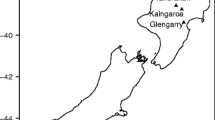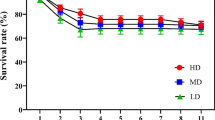Abstract
The effect of orientation, location, year, and pruning treatment on mean acorn mass in two open woodland experimental locations (Huelva, South-Western Spain) of Holm Oak (Quercus ilex L. subsp. ballota [Desf.] Samp.) was analyzed during 2001–2006. Data were analyzed by using a mixed linear model, where the covariates were tree size parameters (circumference at 80 cm height, crown size), topographic position (wet index and flow length), intraspecific competition, total acorn crops per tree (weight and number), and climatic parameters. Average estimated acorn mass was 3.17 g acorn−1 in the Calañas location and 4.12 g acorn−1 in the San Bartolomé location, with significant differences between locations, among individual trees and across years. Acorns from the south sides of trees were significantly heavier than those at other positions. The effect of pruning treatment and the interactions location × treatment and treatment × year were not significant. Our study provides no evidence that pruning affects acorn mass. None of the analyzed covariates related to tree size, topographic position and intraspecific competition explained the difference among trees, suggesting that heritable factors play an important role. Specific climatic parameters during September, the most important month for acorn growth, may explain the effects of year and location × year on acorn mass. In addition, there appeared to be a “trade-off” between acorn mass and number of acorns.

Similar content being viewed by others
References
Abrahamson WJ, Layne JN (2003) Long term patterns of acorn production for five oak species in xeric Florida uplands. Ecology 84(9):2476–2492
Afzal-Rafii Z, Dodd RS, Pelleau Y (1992) Mediterranean evergreen oak diversity: morphological and chemical variation of acorns. Can J Bot 70(7):1459–1466. doi:10.1139/b92-184
Aizen MA, Woodcock H (1992) Latitudinal trends in acorn size in Eastern North American species of Quercus. Can J Bot 70(6):1218–1222. doi:10.1139/b92-153
Akaike H (1974) A new look at the statistical model identification. IEEE Trans Autom Control 19(6):716–723. doi:10.1109/TAC.1974.1100705
Alejano R, Alaejos J, Torres E (2004) Pruning quantification and biomass production in two holm oak dehesas of southwest Spain. In: Arianoutsou M, Papanastasis VP (eds) Proceedings of the 10th international conference on Mediterranean climate ecosystems: ecology, conservation and management of Mediterranean climate ecosystems, Rodhes, Greece, 25 Apr–1 May 2004. Millpress, Amsterdam, pp 40–49
Alejano R, Tapias R, Fernández M, Torres E, Alaejos J, Domingo J (2008) Influence of pruning and the climatic conditions on acorn production in holm oak (Quercus ilex L.) dehesas in SW Spain. Ann For Sci 65(2):209(1–9). doi: 10.1051/forest:2007092
Álvarez S, Morales R, Bejarano L, Durán A (2002) Producción de bellota en la dehesa salmantina. Actas de la XLII Reunión Científica de la SEEP, Lérida, pp 645–649
Beven KJ, Kirkby MJ (1979) A physically based, variable contributing area model of basin hydrology. Hydrol Sci Bull 24(1):43–69
Bondeau A, Kicklighter DW, Kaduk J (1999) Comparing global models of terrestrial net primary productivity (NPP): importance of vegetation structure on seasonal NPP estimates. Glob Change Biol 5:35–45
Bonfil C (1998) The effects of seed size, cotyledon reserves and herbivory on seedling survival and growth in Quercus rugosa and Q. laurina (Fagaceae). Am J Bot 85(1):79–87
Cañellas I, Roig S, Montero G (2006) Pruning influence on acorn yield in cork oak open woodland. In: Mosquera-Losada MR, McAdam J, Rigueiro-Rodríguez A (eds) International Congress on Silvopastoralism and Sustainable Management: Silvopastoralism and Sustainable Land Management, Lugo, Spain, April 2006. CABI Publishing, Oxfordshire, pp 110–111
Cañellas I, Roig S, Poblaciones MJ, Gea-Izquierdo G, Olea L (2007) An approach to acorn production in Iberian dehesas. Agrofor Syst 70:3–9
Carbonero MD, Navarro R, Fernández P (2002) Evaluación de la producción y del calibre de bellotas de Quercus ilex L. subsp. ballota (Desf) Samp. a lo largo de un ciclo de poda: Resultados de la campaña 2000–2001. In: Chocarro C, Santiveri F, Fanlo R, Bovet I, Lloveras J (eds) XLII Reunión de la Sociedad Española para el Estudio de los Pastos: Producción de pastos, forrajes y céspedes, Lleida, Spain, 6–10 May 2002. Ediciones de la Universidad de Lleida, Lleida, pp 633–638
Carbonero MD, Fernández-Ranchal A, Fernández-Rebollo P (2008) La producción de bellota en la dehesa. In: Fernández-Rebollo P, Carbonero MD, Blázquez A (eds) La Dehesa en el Norte de Córdoba. Perspectivas futuras para su conservación. Universidad de Córdoba, Cordoba
Consejeria de Medio Ambiente (2004) Manual de Ordenación de Montes de Andalucía. Junta de Andalucía, Sevilla
David TS, Henriques MO, Kurz-Besson C, Nunes J, Valente F, Vaz M, Pereira JS, Siegwolf R, Chaves MM, Gazarini LC, David JS (2007) Water-use strategies in two co-occurring Mediterranean evergreen oaks: surviving the summer drought. Tree Physiol 27:793–803
Debazac EF (1983) Temperate broad-leaved evergreen forest of the Mediterranean Region and Middle East. In: Ovington JD (ed) Ecosystems of the world 10: temperate broad-leaved evergreen forests. Elsevier, Amsterdam, pp 107–123
Emlen JM (1966) The role of time and energy in food preference. Am Nat 100:611–617
European Environmental Agency (2007) Climate change and water adaptation issues. European Environmental Agency Technical Report no 2/2007
García-Mozo H, Gómez-Casero MT, Domínguez E, Galán C (2007) Influence of pollen emission and weather-related factors on variations in holm-oak (Quercus ilex subsp. ballota) acorn production. Environ Exp Bot 61(1):35–40. doi:10.1016/j.envexpbot.2007.02.009
Gea-Izquierdo G, Cañellas I, Montero G (2006) Acorn production in Spanish holm oak woodlands. Investig Agrar Sist Recur For 15(3):339–354
Greenberg CH (2000) Individual variation in acorn production by five species of Southern Appalachian oaks. For Ecol Manag 132:199–210. doi:10.1016/S0378-1127(99)00226-1
Healy WM, Lewis AM, Boose EF (1999) Variation of red oak acorn production. For Ecol Manag 116:1–11
Hidalgo-Fernández P, Heras MA (2003) The effect of climate fluctuations on tree rings of Pinus pinaster Ait. and Quercus ilex subsp. ballota (Desf.) Samp. In: Ruiz MB, Dorado A, Valdeolmillos MJ, Gil T, Bardají I, De Bustamante C, Martínez I (eds) Quaternary climatic changes and environmental crises in the Mediterranean Region. Universidad de Alcalá de Henares, Madrid, pp 7–12
Jakobsson A, Eriksson O (2000) A comparative study of seed number, seed size, seedling size and recruitments in grasslands plants. Oikos 88(3):494–502
Junta de Andalucía (2005) Modelo Digital del Terreno de Andalucía: Relieve y Orografía. Junta de Andalucía, Sevilla
Koenig WD, Mumme RL, Carmen WJ, Stanback MT (1994) Acorn production by oaks in coastal California: variation between and among years. Ecology 75(1):99–109
Koenig WD, Knops JMH, Carmen WJ, Sage D (2009) No trade-off between seed size and number in the valley oak Quercus lobata. Am Nat 173:682–688. doi:10.1086/597605
Leishman MR, Wright IJ, Moles AT, Westoby M (2000) The evolutionary ecology of seed size. In: Fenner M (ed) Seeds: the ecology of regeneration in plant communities, 2nd edn. CABI Publishing, Wallingford, pp 31–57
Manion PD (1991) Tree disease concepts. Prentice-Hall, London
Martin A, Infante JM, García J, Merino J, Fernández R (1998) Producción de bellotas en montes y dehesas del Suroeste Español. Pastos XXVIII 2:237–248
Navarro R, Fernández P, Trapero A, Caetano P, Romero MA, Sánchez ME, Fernández A, Sánchez I, López G (2004) Los procesos de decaimiento de encinas y alcornoques. Monografia. Convenio Consejería de Medio Ambiente Universidad de Córdoba. Dirección General de Gestión del Medio Natural. Consejería de Medio Ambiente. Junta de Andalucía, Andalucia
Oliveira G, Werner C, Correia O (1996) Are ecophysiological responses influenced by crown position in cork-oak? Ann For Sci 53:235–241
Paço T, David TS, Henriques MO, Pereira JS, Valente F, Banza J, Pereira FL, Pinto C, David JS (2009) Evapotranspiration from a Mediterranean evergreen oak savannah: the role of trees and pasture. J Hydrol 369:98–106. doi:10.1016/j.jhydrol.2009.02.011
Poblaciones MJ, López-Bellido R, Olea L, Benito C (2006) Evaluation of the production of acorns of oaks (Quercus ilex L. subsp. ballota) from southwest of Extremadura, Spain. In: Mosquera MR, McAdam J, Rigueiro A (eds) Silvopastoralism and sustainable land management. CABI Publishing, Oxfordshire
Pons J, Pausas J (2007) Rodent acorn selection in a Mediterranean oak landscape. Ecol Res 22(4):535–541
Rodríguez-Estévez V, García A, Peña F, Gómez AG (2009) Foraging of Iberian fattening pigs grazing natural pasture in the dehesa. Livest Sci 120(1–2):135–143. doi:10.1016/l.livsci.2008.05.006
San Miguel A (1994) La dehesa española. Origen, tipología, características y gestión. Fundación Conde del Valle de Salazar, Escuela Técnica Superior de Ingenieros de Montes, Madrid
Siscart D, Diego V, Lloret F (1999) Acorn ecology. In: Rodá F, Retana J, Gracia CA, Bellot J (eds) Ecology of Mediterranean evergreen oak forests. Springer Verlag, Berlin, pp 75–86
Smith CC, Fretwell SD (1974) The optimal balance between size and number of offspring. Am Nat 108:499–506
Soto A, Lorenzo Z, Gil L (2005) Fine-scale genetic structure in a Quercus suber L.—Q. ilex L. mixed dehesa. In: Vázquez-Piqué J, Pereira H, González-Pérez A (eds) Suberwood: new challenges for the integration of cork oak forests and products. Universidad de Huelva Publicaciones, Huelva, pp 27–36
Tapias R, Moreira AC, Fernández M, Sáenz A, Domingos AC, Melo E, Cravador A (2008) Variability in the tolerant/resistance of Quercus suber L. seedlings to Phytophthora cinnamomi Rands. Evaluation of survival. In: Vázquez-Piqué J, Pereira H, González-Pérez A (eds) Suberwood: new challenges for the integration of cork oak forests and products. Universidad de Huelva Publicaciones, Huelva, pp 237–246
Vázquez-Piqué J, Pereira H (2004) Modelos de crecimiento en diámetro para alcornocales del centro y sur de Portugal. Cuad Soc Esp Cien For 18:219–226
Vázquez-Piqué J, Lago J, González-Pérez A (2001) INCO: programa para el cálculo de índices de competencia de especies forestales. In: Junta de Andalucía (ed) Actas del III Congreso Forestal Español, Granada, 25–28 September 2001, vol V. Coria Gráfica, Sevilla, pp 517–524
Wilbur HM (1977) Propagule size, number and dispersion pattern in Ambystoma and Asclepias. Am Nat 111:43–68
Wolfinger RD (1996) Heterogeneous variance–covariance structures for repeated measures. J Agric Biol Environ Stat 1:205–230
Yu X, Zhou H, Luo T (2003) Spatial and temporal variations in insect-infested acorn fall in a Quercus liaotungensis forest in north China. Ecol Res 18:155–164
Acknowledgments
This study was sponsored by the Department of Innovation, Science and Business of the Regional Government of Andalusia, Spain (ref: C03-192) and by MEC-INIA, Spain (ref: SUM2006-00026-00-00). The authors also wish to thank AECI for funding the PhD student Felipe Carevic.
Author information
Authors and Affiliations
Corresponding author
Rights and permissions
About this article
Cite this article
Alejano, R., Vázquez-Piqué, J., Carevic, F. et al. Do ecological and silvicultural factors influence acorn mass in Holm Oak (southwestern Spain)?. Agroforest Syst 83, 25–39 (2011). https://doi.org/10.1007/s10457-011-9369-4
Received:
Accepted:
Published:
Issue Date:
DOI: https://doi.org/10.1007/s10457-011-9369-4




